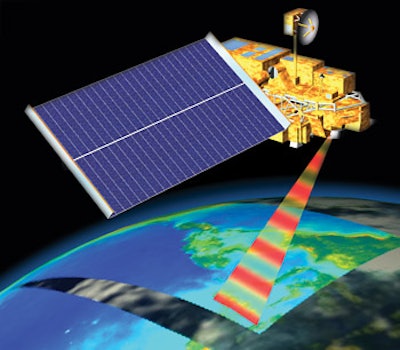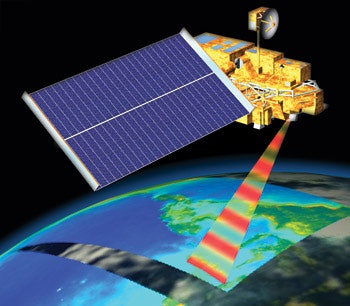
At this very moment, about 466 miles up in space, NASA's Terra satellite is recording atmospheric data across a 1,400-mile-wide swath of Earth. It uses a moderate-resolution imaging spectroradiometer, or MODIS for short, to record phenomena like volcanic eruptions, floods, storms, droughts and forest fires. It may sound irrelevant to daily life, but all of these events can disrupt supply chains wood flooring professionals depend on to get product in the right place at the right time. Forest managers (along with scientists and researchers) are monitoring data from Terra, playing their role in a long line of wood products industry stakeholders, in order to ensure our forests provide satisfactory yields year after year. And they are fighting a winning battle. Though threats to the forest are many, the industry is moving toward global forest sustainability by combining technology onboard Terra with advances in computing, biotechnology and policymaking-making our industry greener than it's ever been.


Up In Space, Down On Earth
What the Terra satellite is doing is called remote sensing. With remote sensing, a satellite in space measures an object hundreds of miles away on Earth's surface. Remote sensing works in forest management because tree leaves reflect or absorb satellite signals, so scientists are able to gauge forest density and boundaries. By comparing data over time, forest managers are able to gauge overall forest health, in addition to watching for natural phenomena. Remote sensing can be a more economical alternative to sending an army of managers through the forest with tape measures every day, although it could never completely replace on-the-ground forest monitoring.
"Remote sensing doesn't compensate for actually working on the ground level," says Jim Carle, a New Zealander who recently retired from serving as leader of the Forest Management Team within the United Nations' Food and Agriculture Organization (FAO). After all, if there's no one on the ground to analyze and contextualize data in an effort to form sound forestry policy, what good is it? Early satellite remote sensing technologies were launched in the 1970s, and Terra and its sister satellite Aqua (which also carries MODIS equipment) have been in orbit for about a decade, but the majority of recent advances in forest management are taking place on the ground, with forest managers gaining access to tools and knowledge that can, hopefully, ensure every forest on Earth is one day sustainable.
Technological Advances
One of those advances is coming from Silicone Valley giant Google. Having gathered petabytes (one petabyte equals a million gigabytes) of global satellite data, it recently launched Google Earth Engine, an amalgam of high-performance computing tools that analyze, interpret and map geographic and environmental data for forest stakeholders, including forest managers. As with any of the company's product offerings, Google Earth Engine is geared for access; the tools are available online-in "the cloud," as technophiles call it-with the complex computing done on Google's side. The project is significant because now forest managers and researchers have a robust central hub at which to conduct research. Throw in Google's savvy marketing and worldwide reach, and just about anyone can keep an eye on things.
"Google Earth Engine has the potential to make available remote sensing data from the past 20 to 30 years so we can actually track change in forests over that time," Carle says. "That's quite exciting."

Google Earth Engine is constantly updated with new data, and this rapid alert to forest change should help in the fight against illegal logging. Today the company is working with a native tribe in the Amazon, the Surui, to outfit them with computers and Android smartphones to access Google Earth Engine, through which the Surui are notified of suspicious changes in rainforest canopy cover. Armed with that information, the tribe members can take the smartphones into the forest to photograph the illegal activity and mark its GPS coordinates. Then the data is uploaded back to Google Earth Engine and the authorities notified.
"If you want to monitor deforestation in the Amazon, it [could take] weeks to run the analysis" using conventional methods, explains Rebecca Moore, who manages Google Earth Engine. "By the time you've done that, the illegal activities are long gone. With Google Earth Engine, you can build a real-time alerting system based on images that show what the state of the forest was last week and what it is this week."
It's clear that this company knows how to make large amounts of data easily accessible, so Google Earth Engine could be a boon for companies like OLAM International, a global agriculture harvester that sources certified and non-certified tropical roundwood, some to wood flooring producers in Western Europe. Lucas Van Der Walt, OLAM's business manager, environmental services, says OLAM invested in remote sensing in 2011 but was a little bit overwhelmed by it. "We got an incredible amount of data, which made it very difficult to re-work into a usable format," he says.
Also in the Amazon, forest managers are outfitting individual trees with microchips to help track timber from the moment it is felled to the point when it's processed. The microchip, attached to the base of the tree, holds data about the tree's location, size and who cut it down, according to a newspaper story from Reuters. Acao Verde ("Green Action"), a public interest group using the technology on a large section of forest in Brazil's Mato Grosso state, says the microchips can provide buyers of forest products key information about where their products come from. The group adds that widespread use of the technology could help eliminate some of the corruption that makes illegal logging possible, including falsification of documents that provide a product's location of harvest.
However, using microchips in forest management has its drawbacks. First, it is labor-intensive to outfit an entire forest stand with microchips. And when a log is cut up at the sawmill, pieces would be left without a microchip. Also, the FAO's Carle adds, sometimes it is difficult to read the microchip in tropical climes "when you're up to your chest in mud."


Biotechnology Work
In addition to advances in computing technology, scientists are improving forest management through advances in biotechnological areas like genetics. The idea to assign every tree on Earth a barcode based on its DNA is still relatively new (see "Flora Bona Fides" from the April/May 2011 issue), but until quite recently the motivation behind the effort has been primarily to tell different tree species apart. Today, however, there is a movement afoot to index tree DNA identifiers in an effort to combat illegal logging. Researchers in Germany are developing a method to pinpoint the origin of a piece of wood on a local level through identifying trace amounts of certain elements (isotopes) in a tree's DNA. Scientists refer to the process as DNA fingerprinting.
While legislation like the United States' Lacey Act helps combat illegal logging, in the end, it relies on paperwork and human declarations. But wood DNA isotopes that vary across continents, countries and climates, on the other hand, are impossible to fabricate and thus more reliable in determining a log's location of harvest. In one test, researchers from the German Society for International Cooperation (with its German initials, GIZ) were able to determine the origin of sapele and iroko samples on a forest concession level in Africa's Cameroon. Still, one of the major obstacles in the path of GIZ's tree DNA project is the establishment of a global repository that would house all of the samples.
"The aim of this study is to develop methods to control chain-of-custody of timber and to determine the place where the tree was felled," says researcher Matthias Fladung of Germany's Johann Heinrich von Thünen-Institut.
But who would wield this technology in the long supply chain from the forest to your client's wood floor? Jason Grant, an independent environmental consultant who did work with the NWFA on its Responsible Procurement Program, says this DNA fingerprinting capability would be best leveraged by watchdog and enforcement groups like U.S. Customs or the Environmental Investigation Agency (EIA). "It allows them to say, 'This wood that has changed hands six times and found its way around the world actually came from this place where illegal logging is a problem,'" he says. He also thinks it is plausible that wood flooring manufacturers could use the technology to check up on competition. "If someone feels they are being unfairly undercut by someone in the market who is using illegal wood," he says, "then they could go out, get a sample, and find out where it came from by paying to get it analyzed."
In other genetic research, forest managers are increasing wood yields in tree plantations through selective breeding. With selective breeding, for example, forest managers can solely plant eucalyptus trees that grow robustly and have a marketable grain, color and texture, or concentrate on species with better resistance to drought or pests. According to Carle, foresters can use biotechnology to program for the kind of tree they want.
Also, foresters can get more from a tree plantation by managing with an end use in mind so that all components of the tree are marketable, from the limbs, to the trunk, to the wood dust created through milling.
"I did a study two years ago that showed if we were to use all the planted forests available and growing, we could supply about two thirds of the current industrial roundwood demand. We don't need to keep cutting down our natural forests," Carle says. "But for various reasons-whether it's civil unrest, or a market downturn, or whatever-it's not all cut at maturity."
Today plantation wood is viewed by a lot of consumers as more green than wood harvested from a natural forest, since harvesting plantation wood does not alter natural forests. Sometimes, though, as Hardwood Floors' Green Blogger Elizabeth Baldwin points out, tree plantations can have unintended consequences. As a result of consumers being turned off by wood harvested from natural forests due to the green movement, Baldwin says that some countries are actually destroying natural forests to make room for plantations. "In my opinion, we do not want to convert native forests into plantations," Baldwin wrote in a July blog post, "but where they already exist or where there is empty ground, plantations are a viable and green opportunity to explore."
Another problem with tree plantations is that while you can selectively breed for a strong tree stand, the breeding is reactive, and tree plantations could suffer a major setback-think Irish potato famine-before a disease, pest or climate threat is identified, Grant says.
Additionally, thinking that wood from a plantation is better than taking wood from a natural forest is often too simplistic, ignoring the reality that much of today's harvesting from forests is sustainably managed for minimal impact (see "Future Forests" from the August/September 2005 issue). Today, there is "a lot of harvesting equipment that is quite sophisticated," Carle says. "In the case of a plantation, it allows you to harvest all the wood there, and in the case of a natural forest, it allows you to manage [the trees] selectively without causing too much impact on the residual stand."
Advancing Policy
Globally, net forest stocks continue to decline, but forest managers are fighting a winning battle in the sense that the rate at which forest stocks are declining is clearly slowing. According to the FAO's "State of the World's Forests 2011," the annual decrease of forest area from 2000 to 2010 was 0.13 percent, whereas during the previous decade the annual decrease was 0.20 percent. Those figures may not look significant, but over the long term, say a century, decline on that scale is certainly significant, so managers must work to make the forests sustainable. This is why global policies like the U.N. program REDD+, short for Reducing Emissions from Deforestation and Forest Degradation, are necessary.
What REDD+ does is create a global market for sound forestry practices with the end goal of reducing global carbon emissions and increasing carbon stocks, i.e., forests that sequester carbon. According to the U.N., deforestation and forest degradation rival human activities (like transportation or energy production) in terms of global net carbon emissions. When forests are degraded, that natural scrubber that helps offset carbon emissions from human activities is degraded. Through REDD+, the U.N. essentially pays countries for increasing carbon stocks by their promoting forest conservation and sustainability through forest management and reforestation.
"I think REDD+ will play a very large part in creating funding mechanisms for all kinds of projects that relate to preserving forests," Grant says. "Right now a lot of people are making money from illegal logging, but with REDD+, hopefully that money can start flowing toward conservation efforts."
In 2011 the U.N.'s REDD+ program welcomed 15 new member countries, spread throughout Southeast Asia, South America and central Africa. These countries will work with the U.N. to build institutional, technical and infrastructure frameworks to implement sound forestry practices on the local level that will grant them access to REDD+ funds. So far, about $51 million has been allocated to REDD+ members.
REDD+ is directed primarily at under-developed countries in which forest resources can be squandered for a quick buck, so the FAO goes to those places and helps educate its civil servants. "It always boils down to governance," Carle says. "You need to have a decent government in place that can secure the resources needed that establish the priorities needed to have the forestry sector recognized for the potential it can give." Hopefully with REDD+ funds, forest management in those countries will get a shot in the arm.
The Sustainable Future
Luckily, the tools necessary to sustainably manage all of the world's forests already exist. The challenge lies in equipping under-developed nations that control huge areas of the world's forests-primarily tropical forests-with these tools. That's where group's like the U.N.'s FAO and the Tropical Forest Foundation (TFF) come in. "There are a lot of exciting technologies emerging in forest management, but it's very difficult to implement them in the tropical forest," says Bob Johnston, executive director of TFF. Johnston's group is an international non-profit that works with stakeholders "on the ground" in tropical forests to spread principles and advantages of sustainable forest management. Some of the groups TFF works with lack knowledge of even basic business practices like inventory management, safety procedures, legal verification systems and harvesting schedules. Teaching modern business practices can be both a shock to the learners' social culture and business culture, he says.
The FAO's Carle recognizes similarities between the TFF goals and what FAO does to educate stakeholders on modern forestry techniques. "One of our goals is to translate that knowledge into palatable forms, to go to the countries and help them understand and apply that science and technology in their own context," he says. "There's still a long, long way to go."
It will take time, but progress is being made. During the United States' logging heyday in the late 19th century, forests were seen as a wild, infinite frontier to be conquered. When the tallest trees were felled, lumberjacks and logging executives posed for photographs, triumphantly perched atop yet another felled behemoth. Now in the 21st century, it's clear that the world's forests are finite. This doesn't mean logging should cease-that would simply void the value in forests, opening them up to increased degradation-but the proper balance between industry and forest preservation must be found to ensure sustainable yields for years to come. To a large degree, that balance has been struck in developed nations like the U.S., but there is much progress to be made in developing nations that hold the world's tropical forests. And that's where forest management, including both old-fashioned boots on the ground and the latest technological advances, comes in to play.































